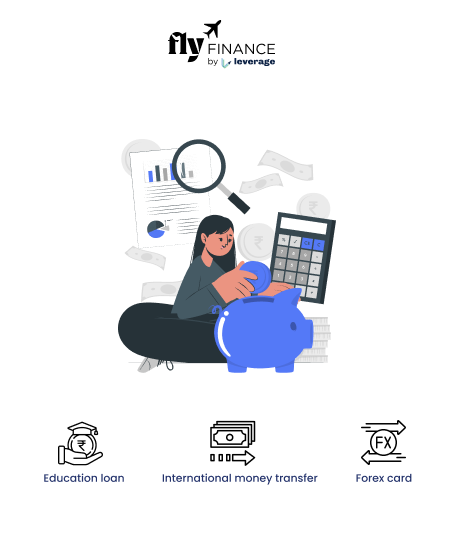Education loans are the second largest contributor to global consumer debt, trailing only housing loans. Millions of students have been able to pursue their desire of studying higher education – both in India and abroad – as a result of the trend gaining in India. Taking out an education loan, on the other hand, is a life-changing decision that should not be taken lightly. If it is not treated properly, it might develop into a chronic headache. This blog includes all the top student loan mistakes that you ought to avoid while applying for your education loan.
1. Making a Conclusion Without Adequate Research
When you decide to apply for a student loan, the first thing you must do is ‘research’. To gain clarification, conduct an internet search and speak with family members and peers, particularly those who have previously taken out such a loan. After acquiring such information, compare several financial firms that provide college loans. You will not be able to get a better financial bargain if you do not compare.
2. Borrowing More Than Necessary
When you decide to take out a loan, consider how much you will spend. Never take more than is required. Remember that the more money you borrow from a financial institution, the more you must return, plus interest. In reality, there are EMI calculators available to help you estimate how much EMI you will have to pay if you take an ‘X’ amount of money today. Before applying for an education loan, every student borrower should use an education loan EMI calculator. It will assist you in making wise financial decisions and ensuring that repaying the loan is not tough in the future.
Must Read: HERE’S HOW YOU CAN GET AN EDUCATION LOAN WITHOUT INCOME PROOF!
3. Not Reading/Understanding the Loan Documents Fine Print
Another one of the student loan mistakes is when many inexperienced applicants wind up signing up for a loan without thoroughly reading the tiny print. This is a bad error. If you or your co-borrower do not comprehend the complexities of financial matters, you should get professional assistance. Contact a member of your family who is familiar with such matters, or pay the extra money to hire an expert who can explain the fine print. Only once you are convinced should you sign the contract. This will spare you from future problems that may arise if you are uninformed of the loan information.
4. Interest Rates are Significant, but not the Only Aspect to Consider
Borrowers frequently regard the interest rate as the most essential consideration when applying for a loan and make their decision exclusively on this. It is a significant consideration, but it is not the only consideration. There are numerous other factors to consider while choosing an education loan.
Examine the schemes available, processing fees, if the education loan covers the total cost of college or just the tuition charge, turnaround time, flexible repayment choices, collateral requirements, and much more. A comprehensive view of all such facts, as well as the college loan interest rate, will assist you in making the best decision.
Must Read: HOW TO NEGOTIATE INTEREST RATE WITH BANKS ON YOUR EDUCATION LOAN? HERE’S THE ANSWER!
5. The Desire for Luxury
It’s difficult to avoid spending money once you have it in your possession. However, your education loan is only for educational purposes, which you should keep in mind while applying for the loan. Instead of using the loan to cover your living expenses, try getting part-time work to fund your non-academic needs.
6. Long-Term Repayment > Short-Term Repayment
Long-term repayment entails paying a little monthly instalment over a lengthy period of time, but short-term repayment entails paying the greatest monthly instalment the student can afford, which clears the debt faster. Students frequently choose the former since it is more comfortable. They fail to note, however, that it also entails returning a significantly bigger sum of money due to the accumulation of interest. Prefer short-term repayment over long-term repayment whenever possible.
Must Read: STUDY ABROAD LOANS: FEDERAL STUDENT LOAN BORROWERS CAN PREPARE TO RESUME PAYMENTS
7. Incorrect Cost Estimate
Taking out an education loan to study abroad is a significant financial decision that requires careful consideration and planning. One of the most common student loan mistakes that are made while taking out a student loan is underestimating the fees.
When planning to study abroad, students usually focus on the upfront costs, such as tuition, living expenses, and travel fees.
However, there are also indirect costs that can quickly pile up, such as those for books, supplies, meals, and travel. Estimating these fees accurately can be challenging, especially if the student has never lived in the country before.
8. Depending on a Single Lender
When taking out an education loan, it’s critical to consider all of your options and not rely just on one lender because doing so raises your risk of making mistakes that could cost you money in the long term. This is again, one of the major student loan mistakes that you need to avoid.
Because there may be fewer options available, it is crucial to study and compare the various loan options to choose which one best suits your financial situation and academic goals.
It is also critical to apply to specialised actors in the education funding area like Fly.Finance or NBFCs, as well as banks. This not only saves time but also reduces the possibility of rejection from banks or delays in the processing of loan applications. Students are working under tight deadlines, and loan delays might put them in a difficult situation.
Must Read: NBFC EDUCATION LOAN FOR STUDYING ABROAD
9. Not Utilising the Moratorium Period
Education debt repayment does not begin immediately after graduation. Students have six months to a year during which they are not forced to begin repaying. This is known as the Moratorium period.
Use this time to start a corpus fund. This amount can then be used to make regular EMI payments or for partial repayment.
Another alternative is to pay back a portion of the interest while still in education. The bank charges interest from the moment you get the education loan. As a result, if you paid the interest while in college, your EMIs will be greatly reduced.
10. Missing Payments
Many students have missed one month’s payment with the intention of making up the difference the following month. That is a huge error. Whether you make up the payment or not, every missing or late payment is a black mark on your credit report and will lower your credit score. This blemish can remain on your credit report for years, hurting your ability to obtain additional loans.
If your monthly payment is too much for you, talk to your lender about a solution before you start skipping payments.
Must Read: STUDY ABROAD: SHRIRAM FIN PLANNING TO OFFER STUDENT LOANS FOR UPSKILLING COURSES
Nowadays, parents recognise the numerous advantages of taking out an education loan and encourage their children to do the same. An education loan allows you to obtain a self-made badge, which makes your parents pleased. Parents assist you in being financially responsible by opting for such a solution. Gradually, you begin to recognise the worth of money and develop a practice of repaying from an early age, so strengthening your credit ratings.
Understanding the rules, processes, and advantages of a higher education loan might be difficult. But don’t be concerned. Please contact us if you have any questions or need assistance. Best wishes!
FAQs
Incomplete documentation, a low credit score, poor academic record, insufficient collateral or guarantor, an unrecognised college or course, and other factors can all lead to education loan rejection.
Yes, an education loan request might be denied if the borrower does not meet the lender’s requirements. Academic, economic, or other factors may exist. Banks will not lend to you if the institute where you want to study does not have a solid placement record.
These are the 5 things to keep in mind to apply for an education loan:
Check the Course and University Carefully.
Check Eligibility.
Keep a Check on Loan Amounts and Policies.
Interest Rates and Moratorium.
Checking Finance Aid Schemes Regularly.
This was all about the student loan mistakes that you should avoid while applying for one. For any further assistance, contact Fly.Finance and let the experts deal with your study abroad education loan application process, documents and everything else.





























